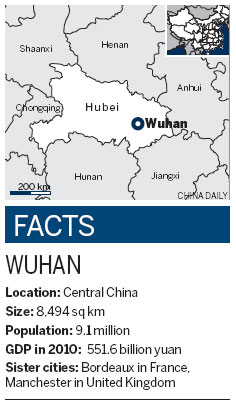Back onto center stage
Updated: 2011-04-29 12:01
By Zhou Lihua and Meng Jing (China Daily European Weekly)
Hubei is one of the six provinces that make up the central hinterland. The central region holds about one-quarter of the nation's population, or 370 million people, which provides a large talent pool for manufacturers and a huge consumption market.
Wuhan's central location also lured Dongfeng Peugeot Citroen Automobile (DPCA), a joint venture between Dongfeng and French automaker
|
|
"When your purpose is to develop your sales network all over China, Wuhan has the perfect location. The logistics make it easy to deliver your cars all over China and use suppliers around the country," says Maxime Picat, general manager of DPCA.
Picat says Wuhan might seem a bit far from most important automobile markets such as Beijing and Shanghai, when the coast was booming in the 1990s.
"But the western development policy gives us an excellent opportunity to accelerate our growth in third- and fourth-tier cities. Because we live in Wuhan and we know inland China," he says.
With the help of its third plant, DPCA plans to increase its production capacity from 450,000 cars a year in 2010 to 750,000 cars a year in 2015, and expand to overseas markets such as South Asia.
"It didn't take long for us making the decision (to build the third plant in Wuhan), after we checked the overall situation in other candidate cities," Picat says.
Wuhan may not as close to the sea as Shanghai or other coastal cities for his company, but Picat says the Yangtze River running through Wuhan can help address that problem.
On the ground, change is happening at a pace that is accelerated even by China's hypertrophied standards.
Five out of the eight planned metro lines in Wuhan are under construction. There are also 5,000 construction sites in the city.
The Wuhan-centered high-speed rail network, expected to reshape China's transport landscape, is scheduled for completion in 2012. The traveling time between Wuhan to Beijing, Shanghai, Guangzhou and Chongqing will be shortened to four hours by then.
Wuhan Tianhe International Airport is also building its third terminal and aiming to be the fourth air transport hub in China, after Beijing, Shanghai and Guangzhou.
The dust and traffic jams coming from the large number of construction sites have not shaken the local government's will to return Wuhan to China's league of front-runner cities and take the lead in the country's development.
Wuhan's GDP in 2005 was 200 billion yuan and it exceeded 500 billion yuan in 2010. According to Wuhan's 12th Five-Year Plan (2011-2015), the government is keen to double its GDP to 1 trillion yuan by the end of 2015.
Tang Liangzhi, mayor of Wuhan, says the city will bring its economy to the next level in its own way. "Wuhan has its own special advantage and we need to make the best of it," Tang says.
The city will make efforts to bring in high-tech companies and those from the advanced manufacturing and modern services industries, Thang says.
Given the advantages in Wuhan's advanced transportation system and its location in the central hinterland, the city plans to combine what it says it does best - higher education to grow the pharmaceutical sector into a new pillar industry to meet its ambitious targets.
In Wuhan National Bioindustry Base, also known as Biolake, the biopharmaceutical industry grew 23 percent in 2010 to reach 24.8 billion yuan. It will likely have an output of 100 billion yuan by 2015, according to Biolake's plan.
Feng Li, chief technology officer in the bioindustry base, says Wuhan's large number of cheap and qualified workforce has attracted many well-known companies including Pfizer, the world's largest pharmaceutical company.
Pfizer announced its plan in October 2010 to set up a research and development (R&D) center in Wuhan National Bioindustry Base, which is considered to be the second of its kind in China after its Shanghai R&D center.
"The most important challenge for setting up R&D centers in emerging markets like China is finding and developing the talent as quickly as we're growing," says Jeffrey B. Kindler, chairman and chief executive officer of Pfizer.
"We are very enthusiastic about the quality of people in China that are available to work for Pfizer. One of the reasons that we are in Wuhan is that there are great scientific centers here, with a million university students in the city," he says.
The total number of university students in Wuhan has surpassed Beijing and Shanghai since 2008. Up to 1.06 million people in Wuhan's 10 million population are in universities and various labs and research centers.
"It is not only about the quantity but the quality. The level of Wuhan's universities is only behind Beijing and Shanghai. Plus, you can hardly find any qualified researcher in Beijing and Shanghai at a salary of 5,000 yuan a month. But in Wuhan, 5,000 yuan can do a lot of things due to the low living cost here," says Feng from Wuhan National Bioindustry Base.
Mu Feng, head of central China with BGI, formerly known as Beijing Genomics Institute, also points out the transportation system that Wuhan can offer.
"We plan to commercialize the research achievements that BGI had in the past 10 years. Wuhan's location can certainly help us reach a huge market in neighboring regions. Plus we need a short delivery time to assure the medicine's quality for clinical practice," he says.
Mu's company has invested 500 million yuan to build an innovation center in Wuhan and will commit another 10 billion yuan for further development in the city.
"I've received nearly 400 applications from BGI's 4,000 employees, who are mainly based in coastal regions, saying that they want to work for our Wuhan branch," Mu says.
Most of the applicants are originally from Hubei but left the central area for better job opportunities, Mu says.
But with the boom in Wuhan, there is no reason for them not to return.
E-paper

Head on
Chinese household care goods producers eye big cities, once stronghold of multinational players
Carving out a spot
Back onto center stage
The Chinese recipe
Specials

British Royal Wedding
Full coverage of the royal wedding of Prince William and Kate Middleton in London. Best wishes

The final frontier
Xinjiang is a mysterious land of extremes that never falls to fascinate.

Bridging the gap
Tsinghua University attracts a cohort of foreign students wanting to come to China.

